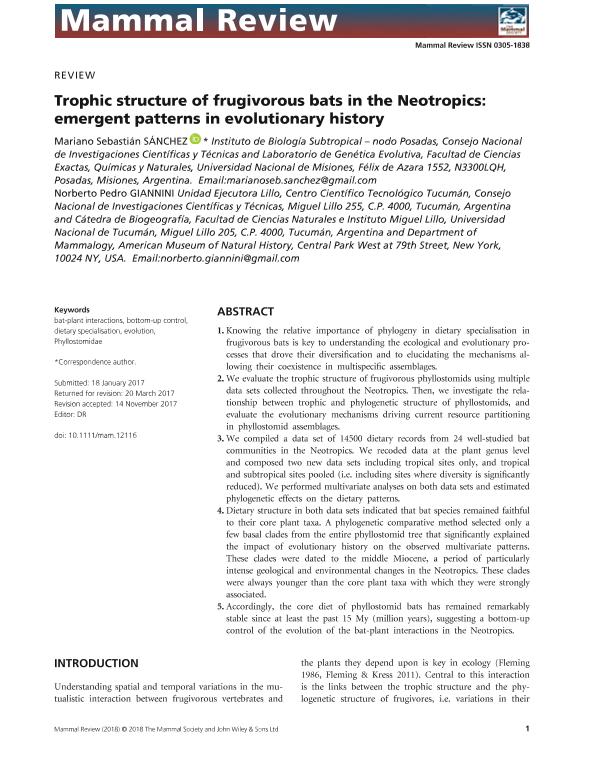Mostrar el registro sencillo del ítem
dc.contributor.author
Sanchez, Mariano Sebastian

dc.contributor.author
Giannini, Norberto Pedro

dc.date.available
2019-10-17T16:04:55Z
dc.date.issued
2018-01
dc.identifier.citation
Sanchez, Mariano Sebastian; Giannini, Norberto Pedro; Trophic structure of frugivorous bats in the Neotropics: emergent historical patterns; Wiley Blackwell Publishing, Inc; Mammal Review; 48; 2; 1-2018; 90-107
dc.identifier.issn
0305-1838
dc.identifier.uri
http://hdl.handle.net/11336/86156
dc.description.abstract
1. Knowing the relative importance of phylogeny in dietary specialisation infrugivorous bats is key to understanding the ecological and evolutionary processes that drove their diversification and to elucidating the mechanisms allowing their coexistence in multispecific assemblages.2. We evaluate the trophic structure of frugivorous phyllostomids using multipledata sets collected throughout the Neotropics. Then, we investigate the relationship between trophic and phylogenetic structure of phyllostomids, andevaluate the evolutionary mechanisms driving current resource partitioning in phyllostomid assemblages.3. We compiled a data set of 14500 dietary records from 24 well-studied bat communities in the Neotropics. We recoded data at the plant genus level and composed two new data sets including tropical sites only, and tropical and subtropical sites pooled (i.e. including sites where diversity is significantlyreduced). We performed multivariate analyses on both data sets and estimated phylogenetic effects on the dietary patterns.4. Dietary structure in both data sets indicated that bat species remained faithful to their core plant taxa. A phylogenetic comparative method selected only a few basal clades from the entire phyllostomid tree that significantly explained the impact of evolutionary history on the observed multivariate patterns. These clades were dated to the middle Miocene, a period of particularly intense geological and environmental changes in the Neotropics. These clades were always younger than the core plant taxa with which they were strongly associated.5. Accordingly, the core diet of phyllostomid bats has remained remarkably stable since at least the past 15 My (million years), suggesting a bottom-up control of the evolution of the bat-plant interactions in the Neotropics.
dc.format
application/pdf
dc.language.iso
eng
dc.publisher
Wiley Blackwell Publishing, Inc

dc.rights
info:eu-repo/semantics/openAccess
dc.rights.uri
https://creativecommons.org/licenses/by-nc-sa/2.5/ar/
dc.subject
BAT-PLANT INTERACTIONS
dc.subject
DIETARY SPECIALIZATION
dc.subject
EVOLUTION
dc.subject
BOTTOM-UP CONTROL
dc.subject
PHYLLOSTOMIDAE
dc.subject.classification
Ecología

dc.subject.classification
Ciencias Biológicas

dc.subject.classification
CIENCIAS NATURALES Y EXACTAS

dc.title
Trophic structure of frugivorous bats in the Neotropics: emergent historical patterns
dc.type
info:eu-repo/semantics/article
dc.type
info:ar-repo/semantics/artículo
dc.type
info:eu-repo/semantics/publishedVersion
dc.date.updated
2019-10-16T19:13:07Z
dc.journal.volume
48
dc.journal.number
2
dc.journal.pagination
90-107
dc.journal.pais
Reino Unido

dc.journal.ciudad
Londres
dc.description.fil
Fil: Sanchez, Mariano Sebastian. Consejo Nacional de Investigaciones Científicas y Técnicas. Centro Científico Tecnológico Conicet - Nordeste. Instituto de Biología Subtropical. Instituto de Biología Subtropical - Nodo Posadas | Universidad Nacional de Misiones. Instituto de Biología Subtropical. Instituto de Biología Subtropical - Nodo Posadas; Argentina
dc.description.fil
Fil: Giannini, Norberto Pedro. Consejo Nacional de Investigaciones Científicas y Técnicas. Centro Científico Tecnológico - Tucumán. Unidad Ejecutora Lillo; Argentina
dc.journal.title
Mammal Review

dc.relation.alternativeid
info:eu-repo/semantics/altIdentifier/doi/https://dx.doi.org/10.1111/mam.12116
dc.relation.alternativeid
info:eu-repo/semantics/altIdentifier/url/https://onlinelibrary.wiley.com/doi/abs/10.1111/mam.12116
Archivos asociados
